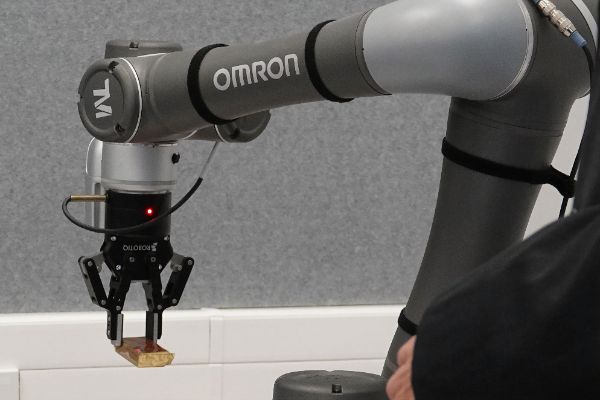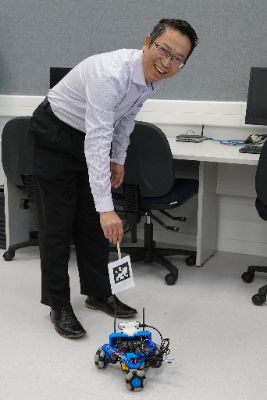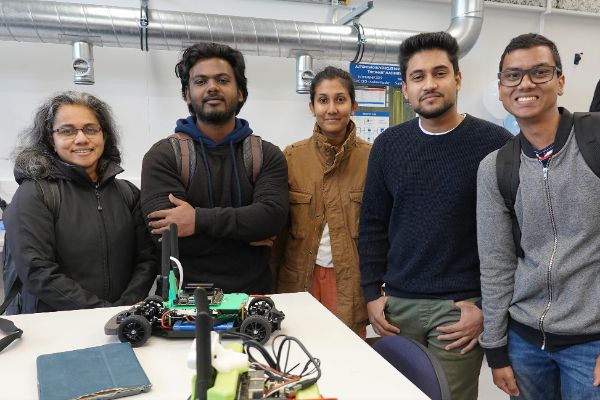EIT Opens New State-of-the-art Laboratory
A state-of-the-art purpose-built Robotics and Artificial Intelligence Development Laboratory, which will allow students to use advanced technology, has been opened on EIT’s Hawke’s Bay Campus in Taradale.
The ribbon was cut by Hilton Collier, Chairman of the EIT Board, in front of staff and students this week.
Fred Koenders, Executive Dean, Faculty of Commerce and Technology, says the lab reflects the Bachelor of Computing Systems’ (BCS) role in Hawke’s Bay businesses, where horticulture processing and manufacturing represents a major contribution to the regional economy.
“These industries are a likely destination for many of our graduates, and where significant productivity gains may well be achieved through pragmatic application of the kinds of technologies housed in this facility.”
The expanded facility doubles the capacity of the original 12-user lab which had quickly become too small for the popular BCS Intelligent Systems major.
EIT partnered with electronics company Omron to showcase the Omron Cobot to Hawke’s Bay industries. The Omron Cobot is a collaborative robot that can be used in a range of different scenarios where robots need to work alongside humans.

This particular one is set up to work with scenarios in the fruit industry and has a vision system that can be taught to recognise different objects.

Students will use the Cobot to develop their skills in programming the robot to recognise specific attributes including looking for blemishes or selecting fruit of a particular shape and size.
The laboratory is also an extension and partnership with the Trades Academy at EIT, where Tutors, at both the Taradale and Tairāwhiti campuses, have provided a training ground for secondary schools interested in technology, including drones and robots, 3D design and 3D printing.
“We need our students to be thinking about tomorrow’s world and to be in a position to lead our organisations through the major changes forced on us by, for instance Covid-19, and the natural evolution of change brought on by competition and the need for efficiency,” Mr Koenders says.

“We are privileged to have this sort of equipment that can do these sorts of things here at EIT. It makes sure that EIT is relevant, up to date and progressive when it comes to our teaching and student learning. But the added advantage is that Hawke’s Bay industry will also get the benefits of this sort of technology.”
Mr Koenders says the new lab includes a deep-learning server for machine vision and learning, HTC Vive Pro wireless virtual reality, a fume-extraction required by the 3D printers, and a workspace that incorporates electrical supplies and bench-space for electronic fabrication and soldering among other things.


 Parrot Analytics: A Very Parrot Analytics Christmas, 2024 Edition
Parrot Analytics: A Very Parrot Analytics Christmas, 2024 Edition Financial Markets Authority: Individual Pleads Guilty To Insider Trading Charges
Financial Markets Authority: Individual Pleads Guilty To Insider Trading Charges Great Journeys New Zealand: Travel Down Memory Lane With The Return Of The Southerner
Great Journeys New Zealand: Travel Down Memory Lane With The Return Of The Southerner WorkSafe NZ: Overhead Power Lines Spark Safety Call
WorkSafe NZ: Overhead Power Lines Spark Safety Call Transpower: Transpower Seeks Feedback On Electricity Investment Short-list For Upper South Island
Transpower: Transpower Seeks Feedback On Electricity Investment Short-list For Upper South Island Commerce Commission: “Cheating The System” – Sentencing In Country’s First Criminal Cartel Case
Commerce Commission: “Cheating The System” – Sentencing In Country’s First Criminal Cartel Case



